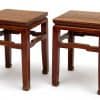Square stools with vertical supports
$2,150.00
Price is for pair of stools
19th century
- elm
- 45cm wide x 45cm deep x 52cm high
Ideal side tables and extra seating.
.
The first known evidence of the seat in China is an engraving of a stool on a bronze vessel dated to the Eastern Zhou period (770B.C. – 221B.C.). However, it is not until the 2nd century A.D. that the first written record of the seat appears. This was of a folding stool and became a symbol of high status in a society that conducted most activities seated on mats. By the 12th century raised seating became the norm. An individual’s social position could be determined with senior people taking chairs while more junior members of the household sat on stools. Perhaps the chameleon of Chinese furniture, when taken outside, the stool would be the seat of honour while others stood.
The stool is described as the “modest wanderer” because they can be found indoors and outdoors in a variety of settings. The stool is one of the most convenient items to have in the home. As well as a place to sit, especially useful when an unexpected large number of guests arrive, they were also used as side tables and standing on to get to the top of high cabinets.
The design, shape and size of stools vary widely to reflect the environments and uses to which they were put. A common thread to all of them, however, is their sturdiness and the intention to offer long-lasting service.



